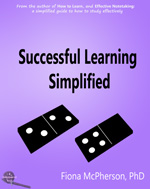Have benefits of a growth mindset been overstated?
- A review of growth mind-set research has found the correlation between growth mind-set and academic achievement was very weak, and may be restricted to some groups of students.
In the education world, fixed mind-set is usually contrasted with growth mind-set. In this context, fixed mind-set refers to students holding the idea that their cognitive abilities, including their intelligence, are set at birth, and they just have to accept their limitations. With a growth mind-set, however, the student recognizes that, although it might be difficult, they can grow their abilities.
A growth mind-set has been associated with a much better approach to learning and improved academic achievement, but new research suggests that this difference has been over-stated.
A recent meta-analysis of growth mind-set research found that
- over half the effect sizes weren't significantly different from zero (157 of 273 effect sizes),
- a small number (16) actually found a negative association between growth mind-set and academic achievement, and
- a little over a third (100) were significant and positive.
Overall, the study found the correlation between growth mind-set and academic achievement was very weak.
Perhaps unsurprisingly, one important factor was age — children and teenagers showed significant effects, while adults did not. Interestingly, neither academic risk status nor socioeconomic status was a significant factor, although various studies have suggested that growth mind-set is much more important for at-risk students.
A second, smaller meta-analysis was carried out to investigate whether growth-set interventions made a significant impact on academic achievement. Such interventions are designed to increase students' belief that intelligence (or some other attribute) can be improved with effort.
The study found that
- 37 of the 43 effect sizes (86%) were not significantly different from zero,
- one effect size was negative, and
- five were positive.
Age was not a factor, nor was at-risk status. However, socioeconomic status was important, in that students from low-SES households were significantly impacted by a growth mind-set intervention, while those from higher-SES households were not.
The type of intervention was important: just reading about growth mind-set didn't help; doing something more interactive, such as writing a reflection, did. The number of sessions didn't have an effect. Oddly, the way the intervention was presented made a difference, with materials presented by computer or by a person not being effective, while print materials were. Interventions administered during regular classroom activities were not effective, but interventions that occurred outside regular activities did have a significant effect.
Taken overall, the depressing conclusion is that mind-set interventions are not the revolution some have touted them as. The researchers point out that previous research (Hattie et al 1996) found that the meta-analytic average effect size for a typical educational intervention on academic performance is 0.57, and all the meta-analytic effects of mind-set interventions in this study were smaller than 0.35 (and most were null).
All this is to say, not that mind-set theory is rubbish, but that it is not as straightforward and miraculous as it first appeared. Mind-set itself is more nuanced than has been presented. For example, do we really have a definite fixed mind-set or growth mind-set? Or is it that we have different mind-sets for different spheres? Perhaps we believe that our math ability is fixed, but our musical ability is something that can be developed. That we can develop our problem-solving ability, but our intelligence is set in stone. That our 'natural talents' can be grown, but our 'innate weaknesses' cannot.
Why would low-SES and high-risk students benefit from a growth mind-set intervention, while higher-SES students did not? An obvious answer lies in the beliefs held by such students. For example, it may be that many higher-SES students are challenged by the idea of a growth mind-set, because they're invested in the idea of their own natural abilities. It is their confidence in their own abilities that enables them to do well, just as other students are undermined by their lack of confidence. Given this different starting point, it would not be in any way surprising if such students responded differently to mind-set interventions.
Sisk, V. F., Burgoyne, A. P., Sun, J., Butler, J. L., & Macnamara, B. N. (2018). To What Extent and Under Which Circumstances Are Growth Mind-Sets Important to Academic Achievement? Two Meta-Analyses. Psychological Science, 29(4), 549–571. http://doi.org/10.1177/0956797617739704
Hattie, J., Biggs, J., & Purdie, N. (1996). Effects of learning skills interventions on student learning: A meta-analysis. Review of Educational Research, 66, 99–136.

